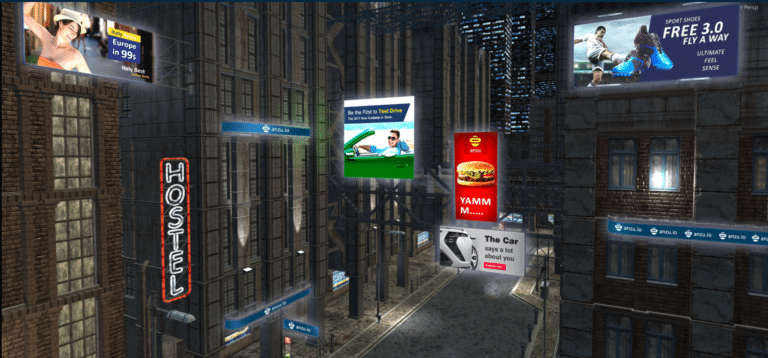
VR and AR will transform several forms of visual media, even advertising. The opportunity is to boost ad effectiveness — or discover new ad strategies — through immersive formats. But could it also raise advertising’s (unloved) profile?
“We have the opportunity to restore advertising’s reputation,” Anzu.io head of sales & marketing Natalia Vasilyeva recently told ARtillry. “It’s a bit bad because of ad obtrusiveness and disruptiveness, but I do believe we have a chance to make it better in VR with native ads.”
Native is the key word, as we’ve examined. Anzu.io hangs its hat on that principle with ad-tech software built for immersive 3D media accross platforms, including analytics like ad tracking. It works primarily with 3D content publishers (like games), and helps them infuse ads naturally.
“We are immersive-first which I found is very important,” said Vasilyeva. “We didn’t start with mobile or desktop and then switch to the VR space. That’s a real differentiator because the core of the technology was built taking into consideration 3D space peculiarities.”
Natural Fit
Though this native approach prevails in the company’s mission, Anzu.io also recognizes that AR & VR are young, so it has to adapt to advertisers’ existing creative. Its transformation engine can port and blend things like 2D banner ads into 3D spaces with dimensional accuracy.
It also broadens its addressable market by casting a wide net with different types of ad-supported content categories and verticals. Vasilyeva names entertainment as a natural starting point, including games, but 3D ad monetization can naturally extend to other contexts.
“Anything that has 3d objects can be branded,” she says. “Corporate [virtual] meeting spaces are interested in adding ads because it makes it more natural. Ads can actually boost the reality. Or if you’re in the middle of a [virtual] big city, you expect big billboards for movies or a show.”
But equally important to ad placement is ensuring good ROI and performance metrics for 3D content publishers. Anzu.io has its own analytics engine, including 3D ad tracking as mentioned above. It also takes this a step further with transactional calls to action, such as e-commerce.
“If you’re in the middle of a soccer game you can take a break and buy the team jersey right in the game,” said Vasilyeva. “After you’re out of the VR experience, you get a notification and can finalize the purchase without interrupting an immersive session.”

Safe Space
Like most of the immersive computing industry, Anzu.io is interested in mobile AR for its nearer-term scale and “stepping stone,” to headset or glasses ubiquity. But with tenure and perspective from the past decade’s ad dynamics, Vasilyeva warns against the dark side of mobile.
“I’m afraid that it will have the same problem as mobile,” she said. “With a lot of demand comes a lot of supply and it’s not always good quality. Every advertising network will try AR. When people see money, they sometimes forget about quality. Fraud will come along I believe.”
By fraud, she means disingenuous practices of ad networks in the gold rush of the smartphone era. It included inflated performance metrics, or outright “click fraud,” (artificially boost click or impression rates and publisher revenue). These are some of the things that can be avoided in VR.
“There is brand safety in VR, because you can’t do fraudulent activities in terms of ad impressions,” she said. “Everything is tracked. We have 3D ad tracker [for] what ads were viewed and for how long, and what part of the creative was viewed or not viewed, all in real time.”

Open For Business
In terms of business objectives, Anzu.io is currently raising series A funding, and gearing up for its late-October product launch. It’s also looking for publishers that want to monetize their 3D content. And because VR is still young, this is a game of education and data collection for Vasileva.
“A lot of publishers are a bit worried about monetization with ads,” she said. “There is a lot of education to do and data can really help. I’m a big believer in good advertising mixed with data. If you don’t have data, you don’t have anything.”
As for the types of companies Anzu.io targets, it’s main constituents are publishers, but it also works with advertisers to bring their ads into publishers’ 3D spaces. Among publishers, there are lots of prospects, including live broadcasters testing out VR — an early but opportune area.
“We’re active on every side,” said Vasilyeva. “We’re open to different types of partnerships because you never know what’s going to come out of it. Great partnerships can start with crazy ideas.”
https://www.facebook.com/anzu.io/videos/1536526839767696/
For a deeper dive on AR & VR insights, see ARtillry’s new intelligence subscription, and sign up for the free ARtillry Weekly newsletter.
Disclosure: ARtillry has no financial stake in the companies mentioned in this post, nor received payment for its production. Disclosure and ethics policy can be seen here.
Header image credit: Lion’s Gate

